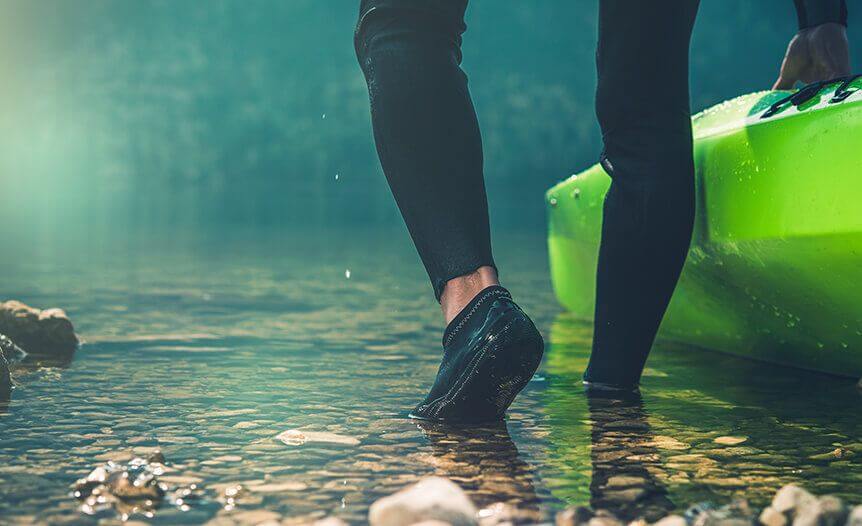Ultimate Guide to Choosing Kayak Accessories

An ultimate guide on kayak accessories to help you understand and choose the best equipment, whether for fishing or just recreational use.
When you first get a fishing kayak, it can be tempting to take it straight out onto the water for some fun. Experience is one of the best ways to know what kayak accessories can add to your enjoyment of these amazing crafts. However, by looking through all the available accessories and thinking about their uses, you can not quickly determine which of them may be necessary for you.
In Australia, kayaking is a fun and popular pastime, and it can be easy to get caught up with thinking about what extra kayak accessories do you need? And the answer is generally not that straightforward.
When it comes to the must-have accessories, starting with the personal safety items is always the best place. A life jacket is an absolute necessity for any kayaker. Just like the seatbelt for your car, a life jacket can save your life in an emergency situation.
In this ultimate guide for kayak accessories from the team at Kayaks2Fish, we'll cover many of the basics. We aim to answer all your questions including, what accessories are needed for kayaks, what do you need for a fishing kayak, and what accessories should I get for my fishing kayak?
Personal Safety
You are generally exposed to the elements when you're out on the water in a kayak (or boat). By adding a few essential accessories, you can paddle and fish knowing you're protected against any possible issues.
In our online shop, you'll find many kayak accessories designed to improve your personal well-being. These items can make your time on the water more fun or stop you from getting into any danger. Making sure you are equipped for all problems on the water is best for keeping your kayaking experience fun for everyone.
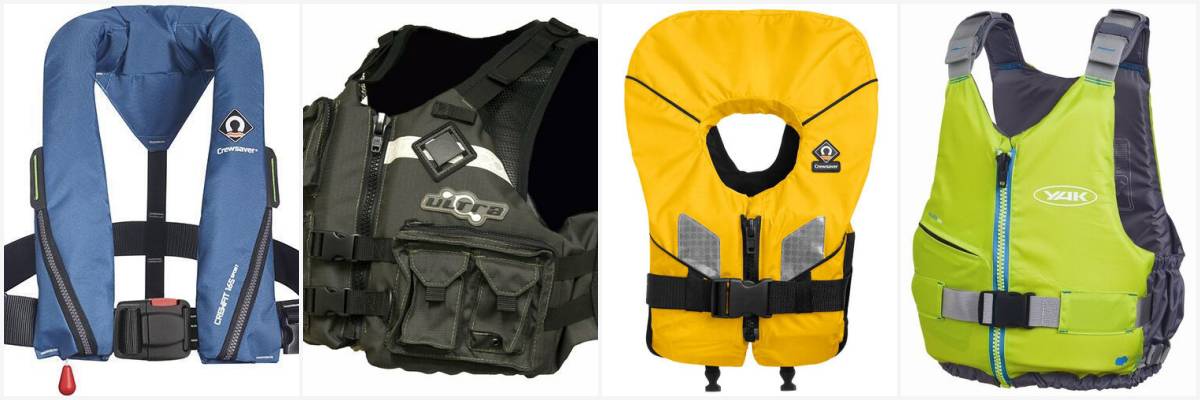
Life Jackets
The life jacket or PFD is an essential item for any trip out on the water. These can save your life if you fall overboard. A good PFD will have an ergonomic design so it is comfortable to wear and keep you afloat in the roughest of waters.
A PFD is designed to give you time to either get back on board your kayak or maintain your positive buoyancy until you're rescued. It doesn't matter if you're kayaking in a river or out to sea, a PFD is going to be the most important part of your gear.
You can find a range of life jackets in an assortment of styles and colours. If you're planning on fishing, you can choose a dark colour or even a camouflaged one if you prefer. For the angler, you can even get a life jacket that includes additional storage pockets.
The two most important points to look out for in a good kayak life jackets are room for arm movement and length. Make sure there is enough room around the armpits so that the fabric doesn't rub against your skin at every stroke. The life jacket also need to be short and should sit around your belly button so that when you sit on the kayak it doesn't ride up to your neck.
If you enjoy taking your dog out on the water with you for a paddle, there are even life jackets for them! While all dogs can swim, a dog floatation device (DFD) has a handle on the back, which means you can quickly get them back on board.
Also, note that buoyancy aids are not the same as life jackets. Buoyancy aids are designed to help you swim but may not hold your body weight in water. The one benefit of buoyancy aids is that they are less bulky and hence the preferred choice for most kayakers. If you wish to have the best of both worlds, then go for an inflatable life vest. They are lightweight and can be used on boats, jet skis and even when rock fishing. The only disadvantage is that they require servicing after certain years.
Also check local state laws, as some states in Australia makes it compulsary to wear life jackets.
First Aid Kits
A first aid kit can be perfect for overnight trips or during your regular kayak fishing session. If you're out on the water and get a hook snagged, then these handy items can stop you from turning in early.
Everyone should have a first aid kit in their vehicle, but often these are not waterproof, which means they can be of little use on a kayak. However, with a first aid dry sack, you can turn any regular first aid kit into one suitable for being on the water.
Standing Assists
When fishing from a kayak, it is often beneficial to do it from a standing position. Kayaks are incredibly stable, but it can help to have additional equipment to make standing up easier for some users.
Depending on your exact needs, several kayak accessories can help get you upright. If you're reasonably confident, then a pair of traction pads will help you keep your footing.
If you need some help standing and sitting comfortably, a pull-up strap will keep you stable on the water. The standing assist bar is perfect for the ultimate luxury when standing and fishing.
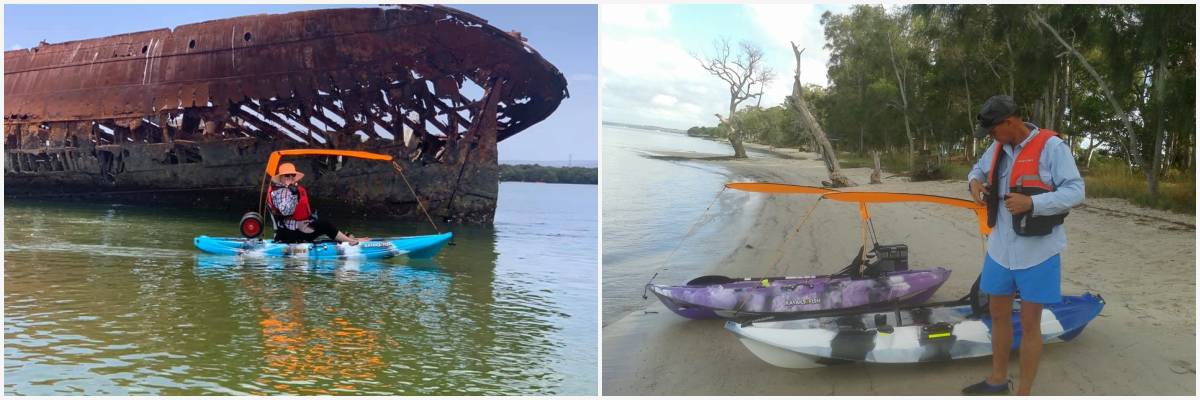
Sun Protection
It can be exceptionally easy to get burnt by the sun while you're kayaking. Taking a wide brim hat and plenty of sunscreens is the most basic cover, and it'll keep you protected from burning. Most kayak anglers ignore to cover the legs only to regret it afterwards.
When you're fishing, it can be easy to forget to reapply sunscreen. To keep on top of your sunscreen application, it is best to set a reminder on your phone.
For the ultimate in sun protection, you can buy a sunshade awning. You can buy a kayak sun awning to suit single or double seater kayaks. With an awning providing you with plenty of shade during the day, it'll help keep you cooler and give you ample protection from the sun. Though we recommend avoiding using it on a very windy day as it may catch the wind and turn your kayak into a sailboat.
Kayak Safety Gear
Keeping yourself safe on the kayak is only one aspect of all the safety options. When looking at kayaking accessories, you'll find many items are designed to keep your kayak safe from damage.
Generally, protecting the kayak is up to the operator, but when you're sitting low in the water, making yourself more visible can help keep your craft safe from other boats.
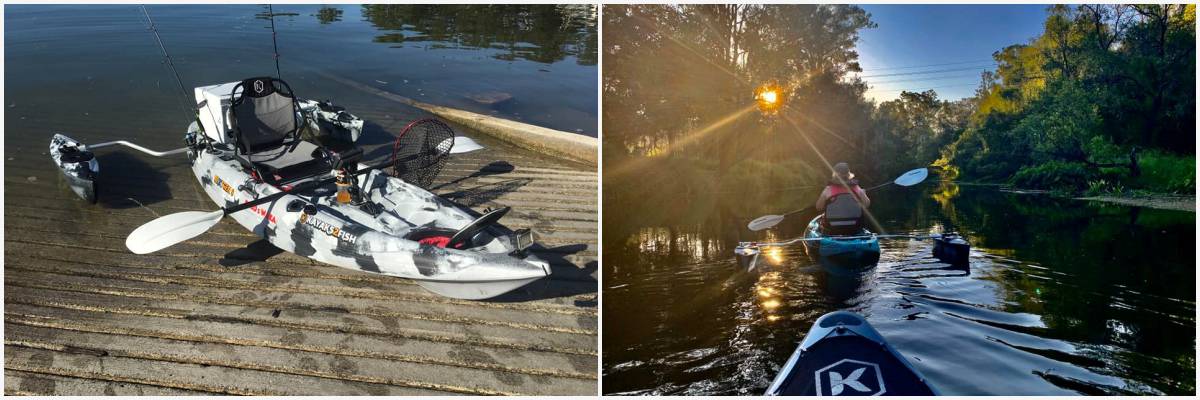
Outriggers
Kayaks are considered very stable on the water, but if you have a boat cruise past, the proceeding wake can upturn your vessel if you're not prepared.
If you're paying attention, you'll have enough time to turn your kayak into the wake and ride it out. However, if your focus is on reeling in fish, a set of outriggers can provide extra stability and lower your chances of flipping over.
In addition to providing stability, some outriggers will contain extra storage. Outriggers are also brilliant for any kayak anglers that are still learning to keep it under their control.
Many fishing kayakers will use outriggers as it provides extra balance during casting and reeling larger fish in. Outriggers are available as inflatable and solid units.
Visibility kits
A kayak flag will make you more visible to powerboat operators. Kayaks generally sit low in the water, and they are easy to miss.
Although everyone should be looking out for each other on the water, relying on others to do the right thing can get you into trouble. By using visibility kits, you increase the chances that you'll be seen.
A basic flag kit will raise the profile of your vessel, but for ultimate visibility, you can buy a flag kit that includes lighting. Adding LED lighting to your flag will provide visibility during low light situations, such as dawn and dusk.
In Australia, most states mandate to have all round 360 degree white light on your vessell before sunrise and after sunset.

Lighting Units
If you're planning on being out at night, you'll need to have suitable lighting installed. Some rules can apply to vessels at sea after dark (while the specific rules may be for a boat, but kayak users should also follow them).
For lighting systems, you'll have a green light on the right, a red light on the left, and an ample white light on the rear. These lights will help other craft detect you and determine in which direction you're travelling. Other craft can also use the lights as an indication of your speed.
In addition to lighting up your kayak, you can use underwater lights to help attract fish and squid. When buying your accessories consider underwater lighting as a part of your overall fishing arsenal. These lighting setups are portable and can also be used on a boat.
Batteries
When you're out on the water for an extended amount of time, having a good source of power can keep all your gear running. The precise amount of power you need will depend on what you plan on running.
If you're running a fish finder, then a battery designed for the task will be ideal (e.g. FPV-Power Combos). For fishing kayaks running electric trolling motors, you may need a battery capable of recharging these while you're on the water.
In Australia, some states require you to carry an boating licenses when using a trolling motor, check your local laws before heading out.
Transportation
Some accessories are designed to help you move your kayak from your home to the water, and these are always handy. Although kayaks are lightweight and easily transported, you can use these aids to make the task easier.
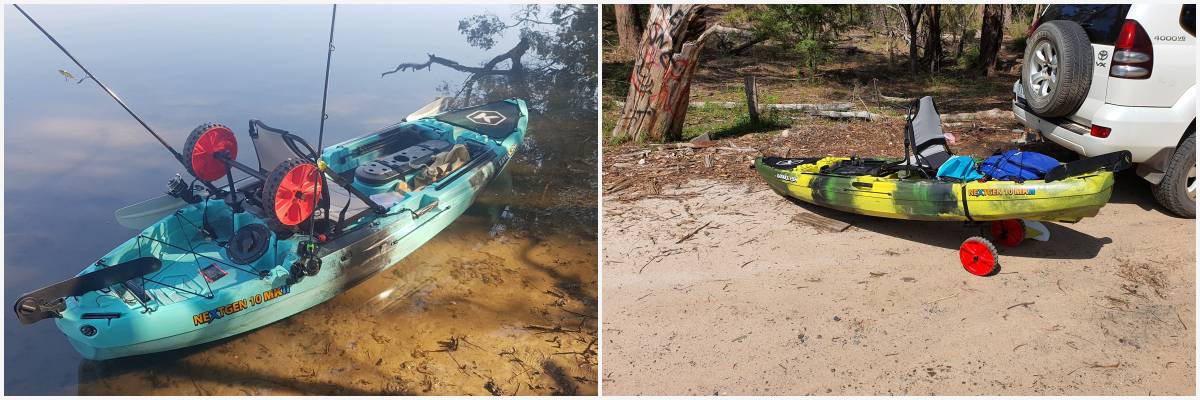
Trolleys
Trolleys are designed to fit all different range of kayaks, and they provide a method for getting your craft to the water. There can be quite a distance to cover with some fishing and kayaking spots, and these wheeled trolleys will make short work of it.
When deciding on a suitable kayak trolley for your needs, consider where you'll be using them. For beaches, you can use a trolley fitted with large wheels suitable for use in sand. On hardened paths or greasy areas, you can use regular wheels.
Some trolleys such as our Sit On Top Trolley is suitable for single kayaks while our Foldable trolley works best for larger kayaks.
Roof Racks
Roof racks are one of the easiest ways to transport your kayak from your home to the water. Unless you're lucky enough to live on the water, odds are you'll need some way to get from your home to the beach or bank. A kayak will fit in the back of most Utes and trailers, but you can use suitable roof racks for all other vehicles. When it comes to choosing roof racks, there are several different options.
For a fast setup, there are soft padded roof racks. For a more permanent solution, you can install J-racks or kayak carriers, though these require you to have crossbars to start with. There are roof racks to hold a kayak vertically and horizontally; your exact expectations will depend on how you prefer to transport your kayaks.
Onboard Storage Options
Kayaks will include plenty of storage options, but you can always have more if you're using these for fishing. Adding storage to your kayak can be straightforward, depending on what you need.
The best ways to know what additional accessories you'll need for storage will come with experience. You may start by using a backpack or other items for storage. However, there are some storage options that most people would consider vital for any kayak angler.
Storage Caddies
Storage spaces on a kayak are often limited, so if you need extra items on board, using these accessories is perfect for all your fishing gear. A storage caddy is a device that attaches to a part of your kayak, and it can attach by a preinstalled rail system or Velcro straps.
If you have an aluminium chair, you can get a tool and tackle organiser that clips to those, providing quick access to essential items. Other storage options for your chair include a backpack that will attach to the upright rails.
When you're on the water fishing, having storage for items like lures, line, bait, fishing pliers, and other fishing accessories is essential. Other storage caddies can make use of any kayak rails that you're not using.
Almost all kayak anglers will require additional storage (for snacks, sunscreen, etc.), and you can start out with one or two options and then expand on them when it's required.
Waterproof Phone Case
While the majority of new phones are waterproof, unfortunately, they don't float. Using a waterproof phone case will keep this essential communications device in arms reach at all times. For the price of a waterproof case, it can save you from buying a new phone.
A good quality phone case will have loops, so you can use a bungee cord to attach it to your kayak for additional security. If you're fishing at night, you can even attach a small LED light or glow stick to the case for extended visibility. The one we stock in our online shop also floats.
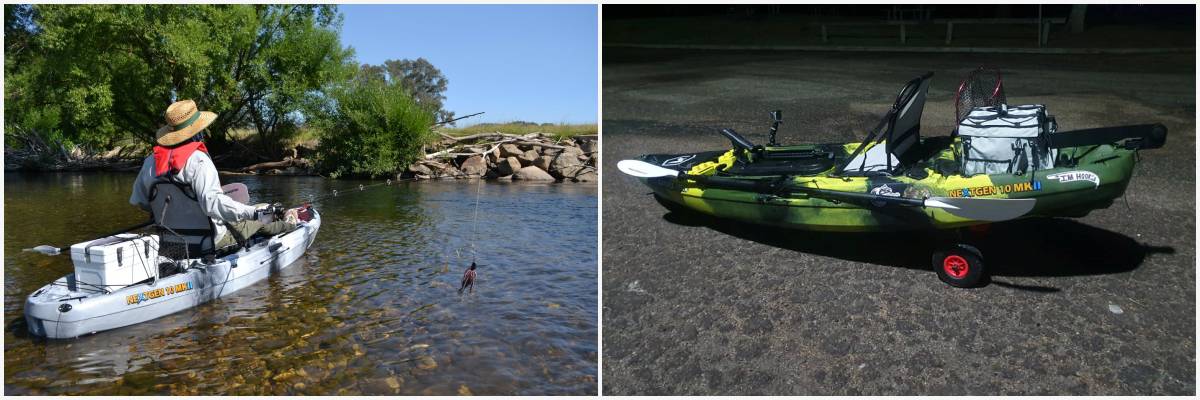
Cooler Boxes
Cooler boxes are another form of storage. These handy items will keep your drinks and snacks cold for the entire trip. The amount and size of your cooler box can be determined by how much storage space you need and where you plan on installing them.
For example, you can get a kayak bow cooler bag for the front storage space, or if you prefer, you can get a round or soft square cooler box behind your seat. These cooler boxes can also be used to hold your daily fishing haul or to keep your bait cold.
Kayak Storage Options
How and where you keep your kayak and paddle is important for maintaining it in good condition. The best place for storing your kayak is in a garage or outdoor shed. Kayaks need to be kept out of the sun when not in use.
By using these accessories, you can make storing your equipment easier, and it'll keep them out of the way if you're storing them in your car garage.
Kayak Covers
A kayak cover will keep your kayak free from any dust or insect problems. Before placing your kayak in these, it is best to make sure they are clean and dry.
While storing your kayak indoors is best, a cover will provide ample protection if you need to keep it outdoors. If you're storing a kayak outdoors, you may prefer to buy a pair of portable stands and a heavy duty kayak storage cover.
Kayak Storage
When you're planning to keep your kayak and paddle in your garage, you may need to use a wall-mounted storage rack. These racks will provide a stable place to store a kayak and keep everything off the ground.
If you do not have the wall space or cannot lift the kayak onto the wall, a hoist system can be a better option. Hoists are ideal for smaller sized garages as they'll keep your gear close to the ceiling, and your car can be parked underneath.
If you're not confident installing the hoist yourself, it may be best to secure the services of a professional. A paddle usually won't be placed into a hoist as these can easily fall unless secured with suitable bungee cords.
Fishing Equipment
When you're out fishing, the type of fishing gear and equipment you need will be unique to your situation. In a fishing kayak, you'll often have flush mount rod holders and an adjustable rod holder as standard additions.
But often, you may need to buy extra kayak fishing accessories to make your day out better. Over time you'll learn what items to include or by talking with other anglers either while you're out on the water or if you join a local fishing club.
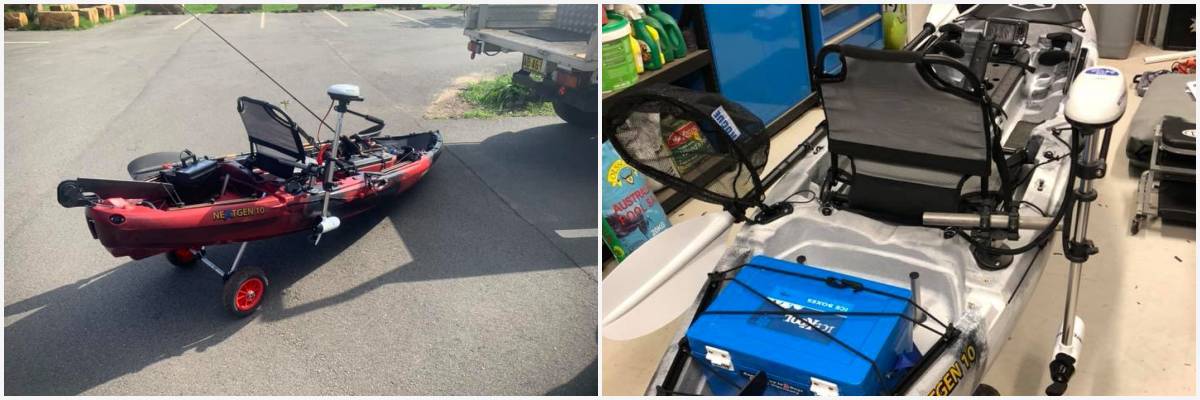
Electric Motors
An electric trolling motor can be ideal for keeping you moving while you're fishing or just to save your arms for more important duties. There are many different options to choose from when looking at an electric motor part of your fishing accessories kit.
Trolling motors are generally hand-operated, but you can buy some that are operated by remote control. Most electric outboards do not require an operator's license in Australia, but it is best to check with your state's current legislation.
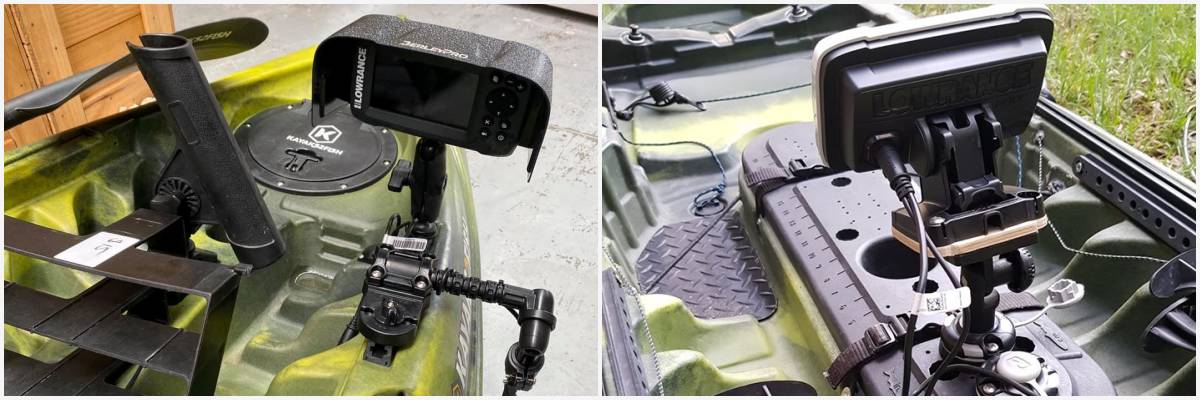
Fish Finders
A fish finder is a perfect way to locate schools of fish in your area. There are many options available with fish finders. When deciding which model is suitable for your needs, consider where you'll be fishing and what types of optional extras you will use.
When you find the right fish finder for your kayak, have a look at the mounts available to help you plan the installation. A fish finder can be one of the best fishing accessories; kayak users often find these are incredibly helpful in locating the best places to drop a line.
Rod Holders
All fishing kayaks will come with a good assortment of rod holders. There are usually central swivel rod holders and a few flush mount rod holders. However, many anglers like to use several rods, and they'll need more space to keep these.
Installing a rod holder gives you the option of taking extra rods, which provides additional odds for catching more fish.
Kayak Anchors
A kayak anchor should be a part of your saltwater fishing gear. These can be perfect for when you hook a large fish as they'll provide a stable grounding and stop the fish from pulling you around. An anchor is a necessity if you are using the kayak as a diving or snorkelling platform.
An anchor trolley kit can also be used when fishing in a running tide, it helps setting the anchoring point on the craft so you can eiter face towards or away from tide current direction.
A 1.5kg anchor is stuitable for most situation but anglers carry two just in case.
What safety equipment is required on a kayak?
The precise safety equipment required when you're on a kayak will depend on which Australian state you're in. Regardless of experience, all fishing kayakers should wear a life jacket or personal floatation device (PDF).
The exact PDF you choose may have a few different styles and appearances, but as with all safety gear, you should choose the best you can afford.
How to choose a life jacket
The best PFDs for fishing and paddling will be those that have larger openings for your arms. With a personal floatation device that is suited for a boat, it may not provide you with the same amount of arm manoeuvrability.
When choosing a PFD, look through the size charts available and make sure you find one that is suitable. A PFD should fit snug and not be loose on your body.
A PFD will provide buoyancy if you fall into the water, and it'll help keep your face out of the water if you are not conscious. In our shop, there is a huge range of life jackets to choose from. All the life jackets we stock are suitable for use in a kayak and a boat.
Keeping your paddle secure
It may not be a requirement, but having a paddle leash is essential and can keep your paddle secure. These are essentially a bungee style cord that attaches your paddle to a part of your body (wrist, life jacket, etc.) or the kayak.
With experience, you may feel the need to go without a paddle leash. All paddles will float, but if you're distracted - like when you're reeling in fish - the paddle can easily slip off and float away; a paddle leash will solve this problem.
Install additional rod holders
Using a rod holder is the best way to secure your rod to your kayak. A good rod holder will provide you with a hands-free means for keeping the rod safe and above water.
In Australia, rod holders are seen as a vital part of any fishing kayak or boat. Many kayakers will install additional rod holders in the stern where they can grab them quickly if required.
What should you always wear when kayak fishing?
Other than your life jacket, the clothes you wear can be up to you. However, it is best to wear clothes that give you adequate protection from the sun. This will include a long-sleeved top and pants.
No matter your experience on a kayak, you're going to get wet, so make sure you only wear clothes that will dry quickly and not be ruined by water. You can also wear a jacket to keep you warm if the wind picks up. You can use the hatch or other storage container to hold any clothes that you are not using.
What should a beginner wear when kayaking?
Kayaks are incredibly stable, but when you start out kayaking, you should prepare to go in the water at some stage. While you may not flip over, getting in and out of a kayak dressed in your regular clothes is something you'll need to practise.
Ideally, wear light clothes that will dry quickly - you may prefer clothes suited to hiking as these are designed for fast evaporation of sweat.
How do you dress while on a fishing kayak?
There are no actual rules for what you should wear when kayak fishing. You can wear the clothes you'd regularly use when fishing from land. However, it may be best to avoid heavy materials like denim and flannel. It's best to check the weather before heading out and dress appropriately. If you're out in the open sea, wind (even on calm days) can be a major factor.
Try to wear something that won't be uncomfortable to swim in, and avoid wearing clothes that have metal zippers. Many kayakers will have a designated outfit to wear while out on the water; asking others can offer you a good guide for you to follow.
What type of fishing gear do you need to bring when you go kayaking?
sunset kayak fishing
Your fishing gear will depend on if you are fishing in a freshwater river or lake or if you are in saltwater. The exact gear you pack can also depend if you plan on using bait or fishing lures. When kayak fishing, it is often best to go after only one or two fish species, and those fish will determine what types of lures you pack with your gear.
After you've been out on an adventure a few times, you'll have a better understanding of what fishing gear you need to take with you. But, provided you have your life jacket, paddle and a comfortable place to sit, then you're ready to go!
What are the best kayaking accessories?
The best accessories are those that will enhance your time on the water. Many accessories aim to provide value for money and increase your enjoyment while you're fishing. This article is a general guide for some of the most popular kayaking accessories.
By talking to other kayakers (or watching videos), you gain a deep understanding of what may be best for your adventures. You can find more information about extra items to add to your kayak by talking to other kayakers.
How do you mount kayak accessories?
Many accessories, especially those designed specifically for kayaks, will come with the appropriate mounting gear. However, there are optional items you can buy, and these will allow you to install an accessory almost anywhere on your kayak (e.g., YakAttack and Railblaza).
How do you secure things in fishing kayaks?
For items that cannot be secured using appropriate mounts, your options include bungee cord or Velcro straps. On most kayaks, you'll be provided with a suitable amount of bungee cord - this is usually in the aft or bow.
A fishing kayak will also have plenty of tie-down points. However, if you need additional tie-down points, these are easy to install. Almost all kayaks will come with a central or forward hatch. When you use the hatch to store things, you are less likely to lose those items as they often have locking lids.
What do you put in a dry bag for a kayak?
Dry bags are ideal for anything you do not want to get wet. This can include your car keys, phone, towels, clothes and a spare pair of shoes. When you purchase a dry bag, make sure it is large enough that you can fit everything you need.
How do you pack a kayak for a day trip?
Whenever you're packing for a day trip (or longer), you want to be mindful of how much gear you're taking. Overloading your craft is never a good idea, so make sure you're aware of how much your kayak can comfortably hold.
If you go fishing, try to keep your fishing gear to a minimum, as you'll need additional space for other items like food, water, and a change of clothes. You may also like to take a small survival kit (matches, first aid kit, etc.) with you if you're planning on stopping at a specific location during the trip.
What should you carry in a kayak?
With a fishing kayak, you're limited with space (unlike boats), and this can limit the amount of stuff you take with you. However, it is these limitations that can make fishing from a kayak more interesting.
Most anglers will target only one fish species during a trip. Provided you plan your trip, you'll have a good idea of the items you need to take with you. Using tools with more than one purpose (e.g., fishing pliers) can help save space on a kayak.
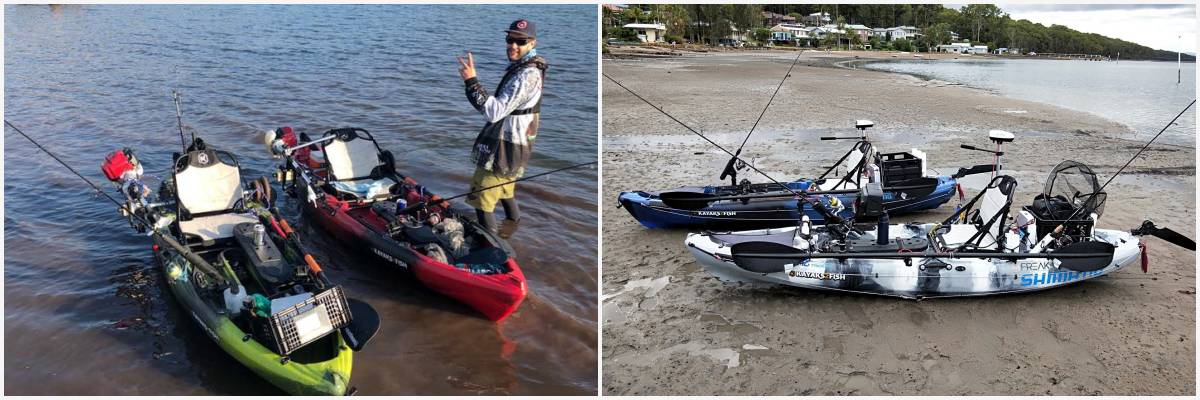
How much can you carry on a kayak?
All kayaks will be rated for a certain amount of weight. With any kayak, you should have an operator weight maximum and a total weight maximum. On any vessel, it is best to distribute the weight all over the craft.
By keeping the weight evenly distributed, you'll be able to control the kayak more easily. When kayaks flip, it is most often caused by being overloaded or improperly loaded.
How do you carry gear on a kayak?
It is best to carry fishing gear on your kayak in secured storage boxes. You can also use straps and bungee cords to keep any loose items secured. Any items that cannot get wet should be placed inside a dry bag. While kayaks are stable and you're unlikely to flip, they will still get very wet due to splashing and runoff from your paddles.
Where do you put your stuff in a kayak?
Many kayaks will have a central hatch that can store several items. Other storage places include under the seat, the rear section, and the forward hull.
Ideally, you should keep items you need at hand close by; this may include fishing pliers and other fish accessories.
If you have a storage cooler box, these are often designed to fit in the rear or forward hull locations. By keeping to these standards, you can ensure you have a good amount of weight distribution.
How do you set up a kayak for fishing?
A fishing kayak should be set up to suit your particular style of fishing. For example, a kayak designed for saltwater fishing may include items you simply do not need for freshwater fishing.
When you're beginning with kayak fishing, the best way to get started is to buy a kayak designed for fishing. This will give you a good starting base, and then you can add to it as you gain experience.
How do you turn a regular kayak into a fishing kayak?
Almost all kayaks are suitable to be used as a fishing platform, but certain types are better than others. If you have a sit-in style of kayak, these are not ideal for fishing as there is not much storage room.
But, provided you have a suitable fishing rod, fishing pliers, a place for your tackle box, excellent bait and lures, and somewhere to keep the fish, then you're all set to get out there and catch some fish!
How do you set up a saltwater kayak?
The best way to set up a saltwater kayak is to start with the right kayak. When traversing saltwater, it is best to use a sit-on-top design.
A sit-on-top kayak will give you all the space you need to install equipment, such as lighting systems, with extra room for all your fishing gear and the fish you catch.
For the best saltwater fishing kayak, you should invest in a quality electric motor as these can help you get out of trouble if the ocean turns against you. You can also make use of a fish finder to help you locate those elusive schools of fish.
Where can I buy kayaking accessories?
Our Kayaks2Fish store is the best place to get all your kayak accessories in Australia. Our online shop has an extensive range of kayak accessories to enhance your experience while you're fishing.
You can order any of these items directly through our online store, and you have the option of having them home delivered or collected from any of our locations.
When looking at the detailed item page in the Kayas2Fish online shop, you'll see where that specific accessory is available in Australia.
If you have additional questions about any kayak accessories for excellent service, please contact our team. You'll also find an extensive FAQ area on our website.





